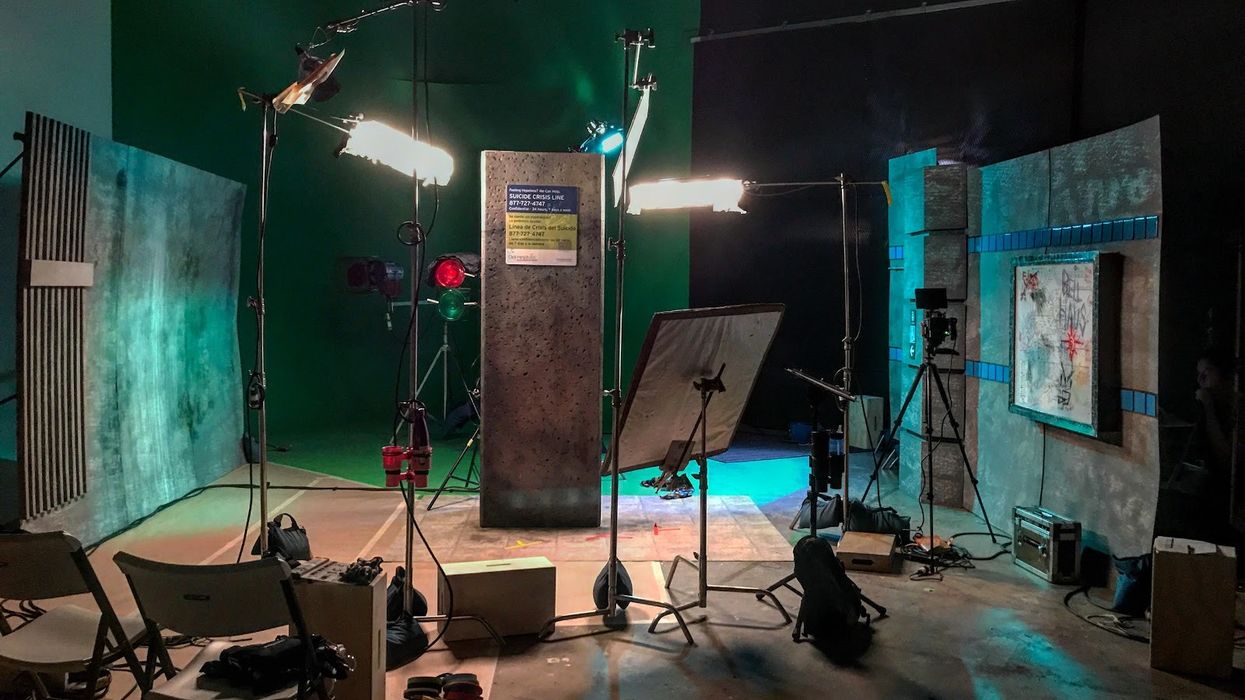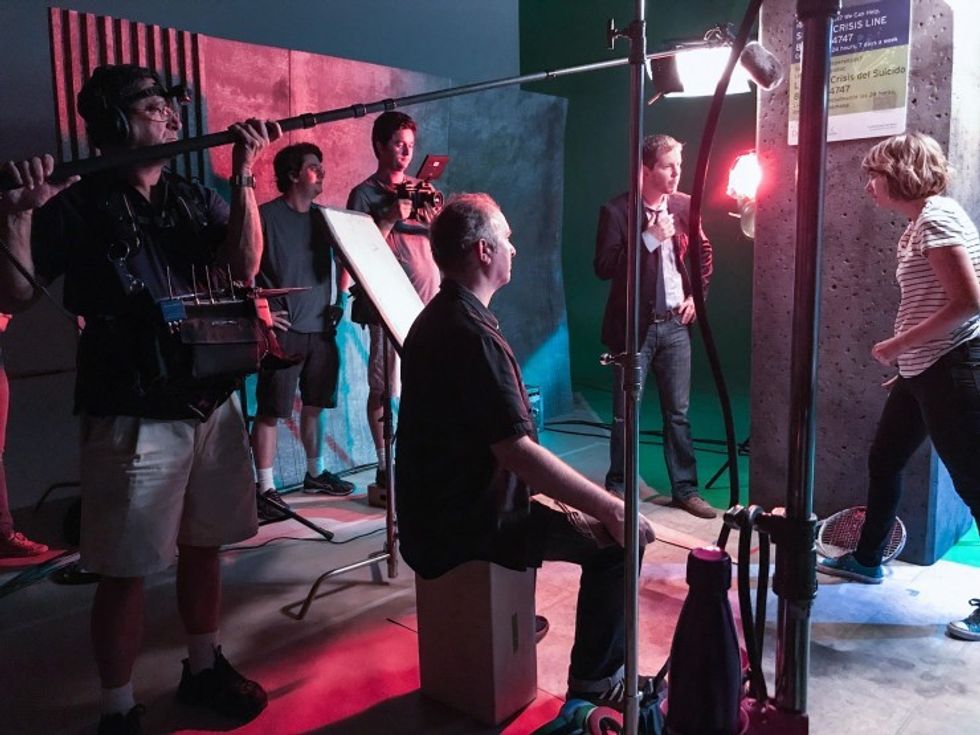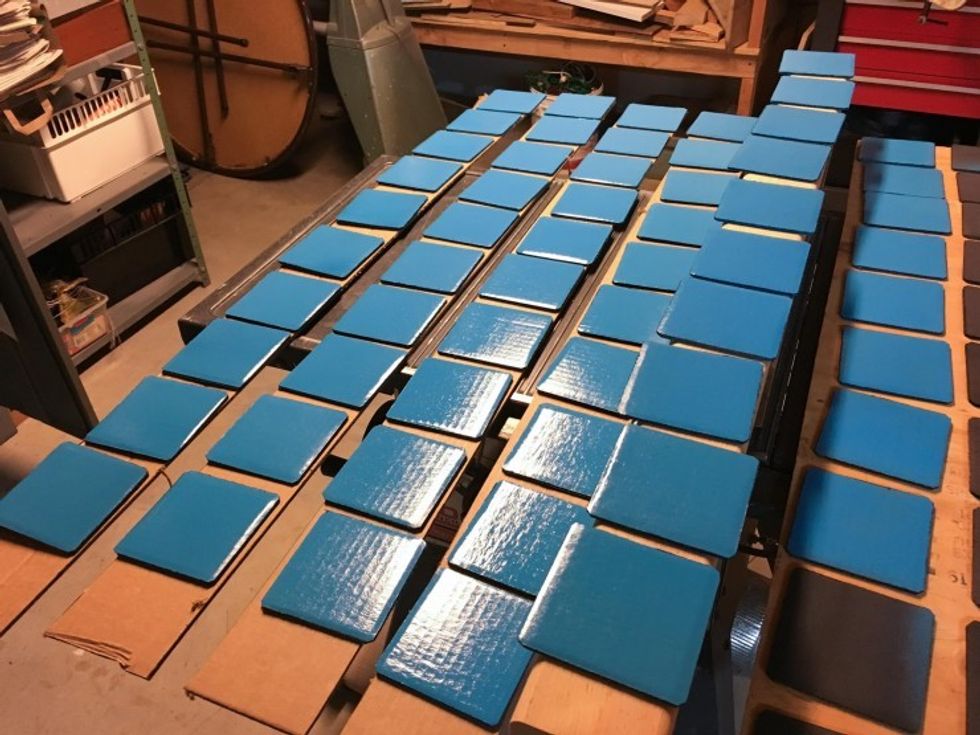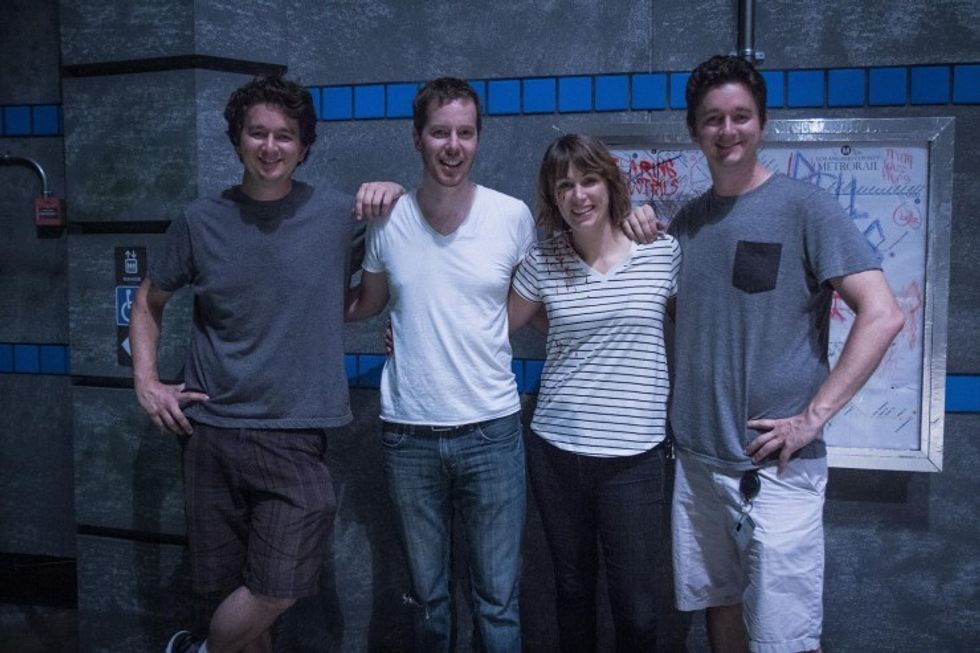How A DIY Approach Resulted in a Subway Station Made From Cardboard
Can’t find the perfect filming location? Maybe you can make it yourself!

David and James Codeglia, director and cinematographer of Deep Dish Apocalypse respectively, took this empowering approach to the challenge of filming in a subway station.
They found a creative low-budget solution to an expensive location problem and delivered high-quality results.
Budget is often the biggest obstacle between filmmakers and making their projects made. Somehow, no matter the size or scope of a project, there’s never enough time, money, or daylight. Especially for low-budget indie films.
One of the BIGGEST challenges a low budget project faces?
Locations.
Permitting a shoot in Los Angeles can run you several hundred dollars, and shooting on location can present many problems from restrictions on filming hours, control of a public space, not to mention finding that ideal, has-everything-you-need diamond-in-the-rough location.
So what are the alternatives? There are a few, some involve breaking the rules and risking it all. Another that we'll focus on today?
Building your own.
The problem here is that regardless of your skill level, renting studio space, getting raw materials, and hiring skilled set builders and suddenly your set build can quickly make the budget skyrocket.
For their short film Deep Dish Apocalypse, David and James needed an abandoned subway platform. In Los Angeles, those are especially hard to come by. They didn’t have the budget for a set build.
So what is one to do when you’re faced with an impossible obstacle?
The DIY Location Solution
They created a subway platform out of cardboard.
"There’s something fun about doing it yourself, doing it low-fi, and just because you have the budget doesn’t mean you can run wild."
Watching the finished product, you would never guess that David and James created this spooky subterranean set using some creative storytelling choices, strategically placed green screen, and a lot of cardboard and hot glue.
Check out their own BTS footage of the process:
Before we dive deep into their process, let's get a little more background on the project and the filmmakers.
For Deep Dish Apocalypse, David and James worked with Bellhouse Productions, headed by Ron Morehouse and Emily Bell. The script, written by Trey Nichols, was initially a play, and then developed it into a short film. The producers are also the stars, and because they work together, they have amazing chemistry.
David was brought on to direct, and James as the cinematographer. James and David are twins, so working together professionally on set has been a natural progression from making projects together growing up.
James and David’s faces light up when they start talking about their early days making movies. David reflects, “We started by making movies in the backyard with their best friends." James agrees, “We were backyard filmmakers.” They made movies with their friends since grade school, using hand me down cameras. With encouragement from their parents, they could make mistakes, learn, and grow. Their do-it-all mindset also evolved out of this kind of down and dirty filmmaking, because when you are just starting out, you have to learn how to do everything yourself.
David reflects, “We started by making movies in the backyard with their best friends." James agrees, “We were backyard filmmakers.”
This skillset proved useful when faced with the challenge of finding a location for Deep Dish Apocalypse.
This story takes place on an abandoned subway station platform during a zombie apocalypse. Trey Nichols had originally written it as a play, where a subway station can be created with a few strategically placed signs and sound design, but when the filmmakers set out to translate this story to screen, they faced a big challenge. How do we film on an active subway platform?
Exploring The Simplest Option First - A Real Location
At first, the filmmakers went for the most obvious option - filming on a working subway platform. They looked into it, but David lamented, “it costs lots of money, and you get zero control over the people, the lighting, and the trains.” James layered another complication, “And, you only get six hours.”
With only two days allotted for the entire shoot, estimating twelve hours each day, it did not seem plausible.
Then, in addition to production restrictions, the real location also didn’t fit the requirements of the story. David reasoned, “if it needs to be empty, dark, and scary - flickering lights, and the trains don’t come, it felt like it was not going to work, even if we could afford it.”
"...it felt like it was not going to work, even if we could afford it."
They considered alternate locations, changing the script. They threw out the idea of a remote bus stop in the middle of nowhere, or an above-ground train station. But, for the filmmakers, it was creatively too restrictive.
David rationalizes, “It didn’t feel the same. There’s something about it being a subterranean world that solves so many script problems. You’re trapped. This is your last chance out, because you can’t go back up.
It’s scary that there are tunnels and the zombies could come from anywhere at any second. There’s a sense that there’s chaos above ground that we don’t need to see. You can also think, well, maybe the trains have been running on their own, or it just hasn’t gotten down here yet. It has to be a subway station.”
Going DIY
After ruling out an actual subway station, the filmmakers had to figure out how they were going to create a believable set.
They looked into abandoned subway stations, or standing subway sets that might already exist, but were only met with dead ends. The next step in the process was an unconventional thought for some, but a natural leap for the Codeglias - What if we built it ourselves?
Building a standing set out of wood was considered, but ultimately ruled out due to logistics and limited resources. James measures, “Wood is expensive. It’s hard to haul. It’s hard to get rid of afterward. It’s also still cost prohibitive. It’s like, how do we rent fewer trucks?” David dives in, “We did a thing called Our Robocop Remake. We made a giant walking cardboard replica of the villain robot, Ed 209. Working with cardboard there, we realized how flexible it was - how easy it was to build with it. It’s easy to cut, bend, shape, fold, and glue together with hot glue. So it’s fast, easy, ready when you need it to be. And we learned you can paint it, and it’s all you need. We thought, we made it look like cardboard on purpose. I bet we could make it look like not cardboard if we wanted to.” James recalls, “The set around him was a good 3/4 of a cyc stage of 8 feet tall cardboard walls, and all of that set construction fit in the back of a van. It lays flat. And it was really affordable.”
This innovative approach isn’t new. James and David were following in the footsteps of their filmmaking heroes who embrace in-camera effects. David recalls when he was working on Star Trek Into Darkness that J.J. Abrams prefers to paint backgrounds when he can, instead of using a green screen. “We totally agree with that, and we thought it would be fun to put into place in this. Because we knew it would be out of focus in the background. We had no question if it would work.”
This confidence has gotten filmmakers into trouble before. But the Codeglia’s had experience and expertise to back them up. David reflects, “We have a lot of experience in visual effects - making them, supervising them. And growing up, we did them. And did a lot of that professionally.” James jumps in, “Visual effects are essential, but the more you can reduce them, the better. The best thing our experience informed was when to use a visual effect and when not to. If you’re a wiz, you might say do the whole thing in visual effects. But for this, we wanted as much in camera as possible. And that’s still a decision visual effects informed decision.”
"Visual effects are essential, but the more you can reduce them, the better. The best thing our experience informed was when to use a visual effect and when not to."
Time also played a critical role in their decision-making process. David muses, “If we had done it all Greenscreen, it would have been weeks and weeks of keying. Post would have been a lot more work for us and we would have done it ourselves. So, the cardboard set was three days of intense work, but it saved us on the back end.”
Going the DIY route also brought an element of fun. David observes, “There’s something fun about doing it yourself, doing it low-fi, and just because you have the budget doesn’t mean you can run wild.”
Narrowing It Down
Narrowing down the cardboard build was essential. Building a life-size 360 cardboard subway station would have been overwhelming, and more importantly, wasn’t necessary for the story to be told.
James elaborates, “We knew from the script, a lot of this is conversation, cross-coverage, you wouldn’t have to build much. You could do a couple of visual effects shots to sell it. The set could be out of focus in the background.”
David chimes in, “We knew we couldn’t build an entire subway. So, the question became, what do we need? Remember all you’re trying to do is capture it on screen, what’s the least we need. If you don’t need it, get rid of it. All about clarity. And to find that answer, we needed to do a location scout. We needed to decide where are we. And if we are using a green screen and replacing it with a real background, we need to know what is the space, so we can copy that, so it feels like it gels.”
James and David went on a detailed location scout. Armed with Artemis’ Pro View Finder on an iPhone, a high-resolution SLR camera, and a measuring tape, they blocked out the entire short on location. They walked through the script, blocking out the action, and choosing camera angles. David remembers, “We pretended we were the actors, and if we look this way for these moments, and this way for these moments - this we can build, this we can’t.”
"We build exactly what we need and not a foot more for those shots."
They recorded all of these choices using the viewfinder app, down to frame positioning and lens choice. James recalls that once they got home with the shots they’d chosen that their next step was, “We build exactly what we need and not a foot more for those shots.”
This required one aspect of creative sacrifice - The actors had to stick to the blocking created on the location scout. David recollects, “We wouldn’t do all the angles we wanted to. We couldn’t have the actors wander from their blocking like maybe we would have wanted to. But, we think the conversation would be captivating enough that you could stay on those angles for a longer amount of time and not need to cut.” They also were able to manipulate the real location by changing the geography in their set. The real subway is two-track, but the one seen in Deep Dish is single-track.
Taking visual inspiration from other sections of the subway station, they created their perfect location out of cardboard. They chose to place one of the actors against the cardboard wall for a multitude of reasons. David expounds, “the great thing that we wouldn’t have gotten on location and we wouldn’t have gotten with a green screen, is lighting interaction. When we flicker our lights off, they are still receiving the light source.” James agrees, “These little things are really hard to replicate in visual effects - not impossible, just hard and expensive and time-consuming - and all said and done, what you could do in green screen for anything just doesn’t look the same.”
“the great thing that we wouldn’t have gotten on location and we wouldn’t have gotten with a green screen, is lighting interaction. When we flicker our lights off, they are still receiving the light source.”
Making It Believable
Now that they’d assessed how much of a build was needed, had narrowed down their shotlist, and made the creative decisions necessary to begin building the set, the filmmakers also had to capture the elements that would be used in place of greenscreen.
Their philosophy of less-is-more carried through. David said, “Our goal with the movie was to make you believe it’s a subway right away. We accomplish that with real in-location shots. When she’s going down the escalator, that’s real. It’s on location. So, why question it ever again? It’s a subway. That’s real.”
They also used another real-life element to enhance the believability of the green-screen-fakery. James points out, “We knew the pillar would be in focus, so it couldn’t be cardboard. IT had to have a concrete texture. So we had production designer to make a concrete replica out of styrofoam.”
They knew from their blocking that the actors would need to interact with the pillar during filming. Capturing the concrete pillar in-camera allowed them to have something tangible on set for the actors to use to ground themselves in the space. They also would be able to capture shadow interaction on the pillar itself. This believable, real interaction with the pillar further convinces the audience that the entire production was real.
The pillar also served a practical purpose in reducing time in post-production. David expands, “Any time we could reduce an edge where green screen interaction was happening, the better. Lighting detail, hair detail. If it could be against the pillar it saves time and money.” James takes a philosophical approach of using the pillar to suspend the audience’s disbelief, “It’s not out of our imaginations. It’s from reality, somehow.” But in order for all of this to work, the cardboard set had to look believable... And the production timeline kept creeping forward.... After all of this pre-planning, scouting, decision-making, they still had to build it...
The Build
First, they assembled their materials. Their expenses totaled approximately $300 worth of cardboard, paint, razors, hot glue, and materials needed for the production designer to construct the faux concrete pillar.
For the cardboard wall, they would be building everything to scale, slightly miniaturized. James recalls that to cut down on time in the studio space where they would film, they “built as much as we could at home, and then brought it to set to finish.”
But painting large flats of cardboard at this size presents its own challenges. David recalls a wrinkle in the plan. “We painted with rollers on big flat pieces of cardboard, and the paint dried, and the cardboard started to curl. So we spent a lot of time reinforcing the cardboard to make it stay flat.” With a one-day build, they had to come up with creative ways to accomplish some trickier aspects of the set they’d designed.
The tiles created for the accent line on the subway wall were also a special challenge because they needed to make them 3-D. Rather than create a wall with a depressed section, they used ingenuity. They painted a section of the tiles in shadow. David calls it “2 and a half D. You create as much as you can in 2D, and then paint 3D on top of that.”
David calls it “2 and a half D. You create as much as you can in 2D, and then paint 3D on top of that.”
The filmmakers also use production design details on top of the cardboard set to sell the idea that this is a working subway station.
They are most proud of a subtle detail - the flickering transparent subway map. They wanted a flickering fluorescent backlit map, and instead of making an actual bulb flicker, David employed a century-old filmmaking technique, rear-screen projection. David explains, “We took a video of a flickering fluorescent bulb, and put it on a monitor on a loop behind the map.”
David employed a century-old filmmaking technique, rear-screen projection. David explains, “We took a video of a flickering fluorescent bulb, and put it on a monitor on a loop behind the map.”
This combination of cardboard, hot glue, modern visual effects, and old-school rear projection synthesizes combines every trick in the book to create a believable abandoned subway platform.
Tools of the Trade
Here are the elements James and David Codeglia used to create a subway station out of cardboard for about $300 in total:
- Artemis - Director Viewfinder’s App
- Tape Measurer - To measure sizes of items to recreate on set, as well as dimensions
- SLR Camera - To take high definition stills to capture textures
- Cardboard
- Razors
- Hot Glue
- Paint & Paint Rollers
Unexpected Challenges?
Although they were prepared for endless mistakes with cardboard (after all, you can hot glue an incorrect cut back together again, or simply replace it with a new inexpensive piece) something David and James were not expecting was how clean Los Angeles subways are. James acknowledges, “If we could have scattered garbage we would have. The footage we captured on actual subways wasn’t scary.” David adds, “Everything is well lit and shiny, so we used distressing our actual set and visual effects to put blood puddles, graffiti.” To solve this problem, James used a floor-based green screen and reports they, “shot clean garbage in our living room, and chroma-keyed it into existing shots.” David jumps in, “I gently blew on the garbage to give it a subway breeze.”
David jumps in, “I gently blew on the garbage to give it a subway breeze.”
Rather than use visual effects to build an entire subway station, they focused on the smaller elements that served the story. David notes, “we also took some solid lights, and flickered them in post. We also erased people who were there.”
Advice for Fellow DIY Filmmakers?
When reflecting on the experience, James and David were quick to point out the importance of pre-planning for an extensive DIY project like this. David synthesizes, “If a picture is worth a thousand words, a rehearsal is worth a million.” He postulates, “In rehearsal, you’re making all of your mistakes for free.” He encourages filmmakers no matter the project to put an emphasis on fixing issues during pre-production.
“In rehearsal, you’re making all of your mistakes for free.”
David also encourages filmmakers to put the emphasis on what is real, not the visual effects. He remarks, “if you can shoot it for real, shoot it for real. If you can’t do that, what’s the next most real thing. Not real is the last result.”
Their final words of wisdom for fellow filmmakers is short and to the point. David encourages, “Get your hands dirty. Have fun.” James recommends, “Be flexible.”
When I sat down with James and David for this interview, I was eager to hear about their experience, but what I wasn’t expecting was for our conversation to touch on something deeper. As filmmakers, we are attempting to do the impossible - capturing fleeting moments for eternity. Preserving the human experience on celluloid. We are sandcastle artists. Kids playing in a sandbox. What I love about the choice of cardboard is not that it’s cheap and easily accessible and budget-friendly. I love that it’s flexible. It’s transformative. It represents so many of the skills independent filmmakers need to get their projects made. This cardboard set isn’t just a way to save money, it’s representative of a filmmaking philosophy. Of finding creative solutions to problems.
Watch the full short Deep Dish Apocalypse here:














